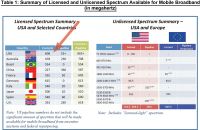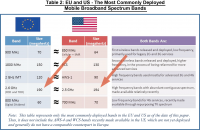In an opinion published in the Wall Street Journal last week, Federal Communications Commission Chairman Julius Genachowski admonished us to keep “discussions focused on solving problems, and on facts and data” when evaluating his spectrum policy proposals. That sounds reasonable, and it could be persuasive, if the FCC based its spectrum policy on consistently applied facts and data.
The FCC has instead chosen to selectively manipulate the facts and data to support its desired policy outcomes. Within a single quarter, the FCC has simultaneously concluded that:
- 194 MHz of spectrum in the 2.5 GHz band is available for mobile broadband services (note: when the FCC wants to show licensed spectrum in the US compares favorably with licensed spectrum on a global basis and that the ratio of licensed to unlicensed spectrum in the US is relatively balanced), and
- Only 55 MHz of the same 194 MHz in the 2.5 GHz band is available for mobile broadband services (note: when the FCC wants to deny a merger or limit the amount of spectrum available to disfavored competitors).
Neither the laws of physics and economics nor the regulations governing the 2.5 GHz band changed the actual facts and data in the intervening period between these inconsistent conclusions. The only things that changed were the results the FCC wanted to reach and the “facts and data” the FCC decided to present to the public.
The FCC concluded that 194 MHz of licensed spectrum in the 2.5 GHz band is available for mobile broadband services in a white paper released on February 26, 2013, which compares the availability of licensed mobile and unlicensed spectrum in the United States and other countries. The first table in the white paper summarizes “the results of [FCC] analyses of licensed and unlicensed spectrum in various parts of the world.” This table (excerpted from page 2 of the white paper) clearly indicates that 608 MHz of licensed spectrum is currently available for mobile broadband and 724.5 to 874.5 MHz of spectrum is currently available for unlicensed use in the United States.
The second table in the white paper compares the most commonly deployed mobile broadband spectrum bands in the US and the European Union. This table (excerpted from page 3 of the white paper) clearly indicates that there is currently 194 MHz of licensed mobile spectrum available in the 2.5 GHz band in the US compared to only 190 MHz in the same band in the EU (which is known as the 2.6 GHz band internationally).
Based on the facts and data represented in these two tables, the FCC makes it appear that the amount of licensed spectrum available for mobile broadband in the US is similar to the amount of unlicensed spectrum available in the US and compares favorably with other countries internationally.
When evaluating mergers, however, the FCC analysis of the facts and data is significantly different. On December 18, 2012 – about two months before it issued the white paper – the FCC affirmed its prior conclusion that only 55 MHz of the total 194 MHz of licensed spectrum in the 2.5 GHz band is available for mobile broadband services. This conclusion had previously been used to show that a merger would result in one company having too much licensed spectrum and to limit the amount of spectrum available to disfavored competitors generally.
It appears that the FCC considers the entire 194 MHz of licensed spectrum in the 2.5 GHz band as available for mobile broadband in the US when the ratio of licensed to unlicensed spectrum and international pride are at stake, but only 55 MHz is available when the FCC considers the impact of licensed spectrum aggregation on mobile competition. If the 139 MHz of spectrum the FCC excludes from its calculations when considering mergers is excluded from the international comparison in Table 1 of the report, the total licensed spectrum in the US that is available for mobile broadband drops from 608 to 469 MHz. The FCC presumably wished to avoid this “fact”, because it would indicate that the US has less licensed spectrum available for mobile broadband than every country in the sample except China and the UK, and that the US has nearly twice as much unlicensed spectrum as it has licensed spectrum.
According to the law, economics, and physics, spectrum is either “available” for mobile broadband or it is not. An agency that is truly “focused . . . on facts and data” would not pretend otherwise by manipulating facts and data to satisfy its desired results. Sadly, over the last three years, the FCC has demonstrated it is no such agency.



 The Technology Liberation Front is the tech policy blog dedicated to keeping politicians' hands off the 'net and everything else related to technology.
The Technology Liberation Front is the tech policy blog dedicated to keeping politicians' hands off the 'net and everything else related to technology.